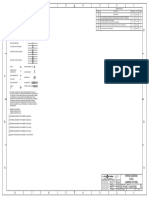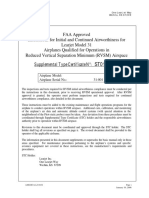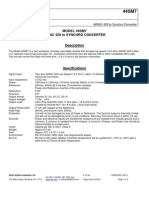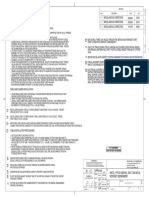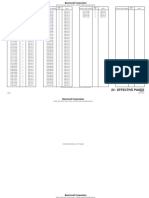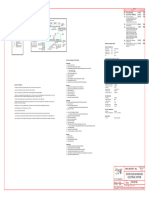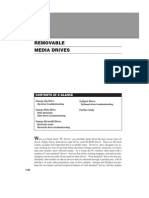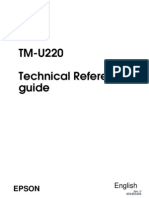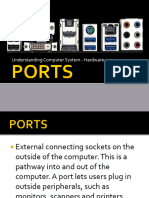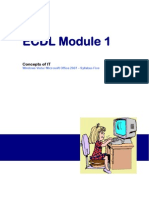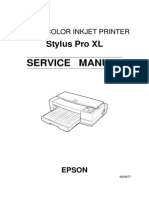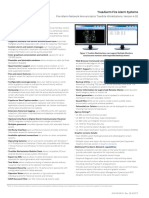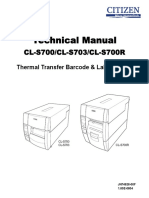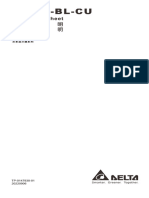TECHTEST LIMITED
Commercial In Confidence
RE-PROGRAMMING MANUAL
FOR
EMERGENCY LOCATOR
TRANSMITTER G-SWITCH
TYPE 503 SERIES
VARIANTS COVERED
503-7, 503-7-1, 503-7-2, 503-19, 503-19-1, 503-19-2
503-25, 503-25-1, 503-25-2
Issue : 3
Dated : 2 3 .0 4 .0 2
CN : TT693
- WARNING -
ANY CHANGES TO THE COSPAS/ SARSAT MESSAGE MAY REQUIRE
NOTIFICATION TO THE RELEVANT NATIONAL AUTHORITY
1 of 24
HRS1014-04-02
� TECHTEST LIMITED
Commercial In Confidence
- PREFACE –
The purpose of this document is to provide:-
• Instructions on changing (re-programming) the Cospas Sarsat (C/S) message that is
stored in the ELT system.
• Information on the GPS protocols supported.
The 503 series ELT is actually an assembly. The main electronic assembly comprises three
parts. These are the Emergency Location Transmitter (ELT), the ELT battery pack and the
G-Switch.
The G-Switch has the C/S message stored in non-volatile memory. When the system is
tested or activated it writes the message to the non-volatile memory in the ELT. So at any
time the ELT can be separated from the G-Switch and operated independently.
So to change the message that is transmitted, the G-Switch is re-programmed. When this
document refers to the G-Switch it can be the G-Switch on its own or as part of an ELT
system.
Please Note
It is advisable to be familiar with the Microsoft Windows operating environment or to have
access to someone who is. Also a basic understanding of the computer hardware is
advisable but not essential.
This manual has been written assuming that the reader has some knowledge of computers.
Issue 3 - 23.04.02 2 of 24
CN - TT693
HRS1014-04-02
� TECHTEST LIMITED
Commercial In Confidence
CONTENTS
PREFACE 2
ELT SYSTEM PROGRAMMING
1 Introduction 4
2 Programming Kit Requirements 4
3 Equipment Required 4
4 Setting Up The Hardware 5
5 Setting Up - Computer 5
6 Re-Programming 5
7 Re-Programming Method 7
8 Printing 8
9 Troubleshooting 8
GPS FUNCTION
10 GPS Operation 9
THE COSPAS SARSAT SYSTEM - OVERVIEW
11 Cospas Sarsat Message 10
12 Function Of The Bits In The Message 10
13 BITS 40 – 83 – Identification Data (Non Serialized Types) 11
APPENDIX 1. 13
14 Computer Setup 13
15 Hyper Terminal Setup – First Time Use 13
16 Saving The Session 19
APPENDIX - EQUIPMENT INTERCONNECTIONS 20
APPENDIX 3 - NMEA GPS MESSAGE FORMAT 21
17 NMEA GPS Message Format 21
APPENDIX 4 - Trimble TNL 2000 GPS Message Format 22
18 TRIMBLE TNL 2000t GPS FUNCTION 22
APPENDIX 5 - INFORMATION REQUEST FOR C/S MESSAGE 23
19 Overview 23
20 Information 23
Issue 3 - 23.04.02 3 of 24
CN - TT693
HRS1014-04-02
� TECHTEST LIMITED
Commercial In Confidence
ELT SYSTEM PROGRAMMING
1. INTRODUCTION
The main components of the ELT system are the G Switch and the transmitter
(ELT). When the ELT is activated it transmits a digitally encoded message on
406.025 MHz (C/S message) for reception by the Cospas Sarsat (C/S) satellite
system. This message is stored in the G Switch and the ELT. When the system
is tested or activated, the message is transferred from the G Switch to the ELT.
So if the message requires changing it is only necessary to re-program the G-
Switch. Re-programming uses the serial interface on the G Switch. As this varies
according to the type of G-Switch, the equipment required varies also.
2. PROGRAMMING KIT REQUIREMENTS
The equipment required for re-programming depends on the type of G-Switch and
is as follows:-
G Switch Serial Port Programming Description
Type Kit
503-7 Philips I2C 12-503-3 Intelligent I2C to RS 232 adapter & cables
503-7-1 RS 232 101-17 RS 232 G-Switch to PC cable assembly
503-7-2 RS 422 12-503-4 RS 422 to RS 232 adapter & cables
503-19 Philips I2C 12-503-3 Intelligent I2C to RS 232 adapter & cables
503-19-1 RS 232 101-17 RS232 G-Switch to PC cable assembly
503-19-2 RS 422 12-503-4 RS 422 to RS 232 adapter & cables
503-25 Philips I2C 12-503-3 Intelligent I2C to RS 232 adapter & cables
503-25-1 RS 232 101-17 RS232 G-Switch to PC cable assembly
503-25-2 RS 422 12-503-4 RS 422 to RS 232 adapter & cables
3. EQUIPMENT REQUIRED
In addition to the above, the following is required:-
• A computer (desktop or laptop) with a spare serial port, and a PS2 port
running Windows 95/98 and Hyper Terminal. (See Appendix 1)
• 28V DC Power Supply (If G Switch battery is flat).
• A printer (optional).
Issue 3 - 23.04.02 4 of 24
CN - TT693
HRS1014-04-02
� TECHTEST LIMITED
Commercial In Confidence
• The G-Switch to be re-programmed.
Depending on the computer being used, a 25way to 9 way serial port adapter and
a PS2 Port splitter may also be required.
4. SETTING UP THE HARDWARE
Appendix 2 details the set up procedures for the various adapter kits and G Switches.
5. SETTING UP – COMPUTER
Firstly check that Hyper Terminal is installed on the computer. The quickest way
is to perform a search by selecting <Start> on the menu bar, followed by <Find>
followed by <Files or Folders> . In the “Named” window type hypertrm.exe then
select the <Find Now> tab. If it is not found then it will need installing.
If it is suspected that HyperTerminal has already been setup for programming
ELTs, but the saved session cannot be found, use “Find” as above but in the
“Named” window type elt_4800.ht
If it is installed but not setup for re-programming ELTs it will need setting up.
Refer to Appendix 1 for a detailed guide to setting up Hyper Terminal.
6. RE-PROGRAMMING
Depending on the type of G Switch being re-programmed read Section 6.1 or
Section 6.3.
6.1 Re-Programming - 503-7-1, 503-7-2, 503-19-1, 503-19-2 503-25-1, 503-25-2
Double click on the Hyper Terminal Session elt_4800.ht to run the program. If this
does not exist it will need to be created using the instructions contained in
Appendix 1. Activate the G-Switch by moving the ON/OFF/ARM switch to the
ARM position. If the battery is flat there is a power supply connection available on
serial lead 101-16.
To enter programming mode, the following sequence of three keys must be
pressed, / # ’ (no spaces between).
6.1.1 Aborting Programming - 503-7-1, 503-7-2, 503-19-1, 503-19-2,503-19-1,
503-19-2
If for any reason the computer is switched off or Hyper terminal is exited during
Issue 3 - 23.04.02 5 of 24
CN - TT693
HRS1014-04-02
� TECHTEST LIMITED
Commercial In Confidence
programming it will be necessary to reset the G-Switch by moving the
ON/OFF/ARM switch to the OFF position and repeating the operations in Section
6.1 as applicable.
6.2 Re-Programming - 503-7, 503-19, 503-25
Double click on the Hyper Terminal Session elt_4800.ht to run the program. If this
does not exist it will need to be created using the instructions contained in
Appendix 1. Activate the G-Switch by moving the ON/OFF/ARM switch to the
ARM position. If the battery is flat there is a power supply connection available on
serial lead 101-14.
To enter programming mode press the <ENTER> key.
6.2.1 Aborting Programming - 503-7, 503-19, 503-25
If for any reason the computer is switched off or Hyper terminal is exited during
programming it will be necessary to reset the adapter by removing the connector
plugged into the PS2 port and plugging it back in repeating the operations in
Section 6.1 as applicable.
The following programming screen will appear (the actual details may vary):-
Issue 3 - 23.04.02 6 of 24
CN - TT693
HRS1014-04-02
� TECHTEST LIMITED
Commercial In Confidence
7. RE-PROGRAMMING METHOD
The programming system is entirely menu driven and prompts for the information
required. Provided the re-programming data is available, programming is straight
forward.
Section 4 gives an overview of the C/S message and Section 5 goes into the
message structure in more detail. If further information on beacon encoding is
required Cospas/Sarsat Publication C/S T.001 is recommended for reading.
7.1 Entry of 22 digit Hex Code
If prompted to “Enter 22 Digit Hex Code”, type N. This facility is only used if
access to the 22 digit Hexadecimal code is available.
Issue 3 - 23.04.02 7 of 24
CN - TT693
HRS1014-04-02
� TECHTEST LIMITED
Commercial In Confidence
7.2 Re-programming options
The following gives an overview of the main programming options available.
• Change Message? Y/N
• Change Country Code? Y/N
• Change User protocol (Aviation, Serial or Test)
• Change Beacon Type (applies to Serial User Protocol only)
• Change or Enter identification data
8. PRINTING
If required, the programming screen can be printed. To print select <File> then
<Print>, and when the Print Window appears select <OK>
9. TROUBLESHOOTING
If nothing happens when the <Enter> key (or / # ’ key sequence) is/are pressed
do/check the following:-
• Switch the G Switch off and back on again
• If an adapter is being used unplug plug back in the PS2 connector from the
computer.
• Check that the cables are plugged in correctly
• Check the Hyper Terminal settings.
• Check that the Correct Serial Port has been selected.
Issue 3 - 23.04.02 8 of 24
CN - TT693
HRS1014-04-02
� TECHTEST LIMITED
Commercial In Confidence
GPS FUNCTION
10. GPS OPERATION
The G-Switch has been designed to receive GPS data in ASCII format. The G-Switch
processes the data and incorporates the latitude/longitude data into the C/S
message.
The data formats supported are detailed in the appendices. It should be noted that it
is vital that the data is presented in exactly the same format as shown in the
appropriate appendix.
Issue 3 - 23.04.02 9 of 24
CN - TT693
HRS1014-04-02
� TECHTEST LIMITED
Commercial In Confidence
THE COSPAS SARSAT SYSTEM – OVERVIEW
11. COSPAS SARSAT MESSAGE
An ELT designed for operation with the COSPAS/SARSAT (C/S) satellite system
transmits, when activated, periodically, a digitally encoded message on 406.025
MHz for reception by the satellite system. On reception of a transmission, the
satellite sends the message to a ground station where it is acted upon.
11.1 The Message
The message is 112 binary digits (bits) long and the data transfer rate is 400 bits a
second.
The message format is as follows:-
BITS DESCRIPTION
1 to 15 Bit Synchronisation
16 to 24 Frame Synchronisation
25 to 85 Protected data field
86 to 106 BCH error correcting field
107 to 112 Non protected data field
12. FUNCTION OF THE BITS IN THE MESSAGE
12.1 BITS 25-39
The function of these bits is the same for all message formats.
BIT 25 – FORMAT FLAG
This is determined by the message type.
1 Long message, 0 Short message
BIT 26 –PROTOCOL FLAG
This is set as follows:-
1 User Protocol, 0 Location Protocols
BIT 27-36 – COUNTRY CODE
Issue 3 - 23.04.02 10 of 24
CN - TT693
HRS1014-04-02
� TECHTEST LIMITED
Commercial In Confidence
These 10 bits designate a three digit decimal country code number expressed in
Binary notation. Country codes are based on the International Telecommunication
Union (ITU) Maritime Identification Codes. (ITU Radio Regulations Appendix 43
Table 1.) Example:-
Great Britain 232 0011101000
Italy 247 0011110111
For all protocols except for the test protocols the Country Code designates the
country of beacon registration. For a test protocol the country code would
generally be the country the beacon was manufactured in.
BITS 37 – 39 – PROTOCOL CODE
These three bits designate the beacon type. Some examples follow:-
001 Aviation User ELT
111 Test User Protocol
110 Serial User Protocol
13. BITS 40 – 83 – IDENTIFICATION DATA (NON SERIALIZED TYPES)
The data structure within these 44 bits is determined by the protocol code. These
examples should make it clear:-
AVIATION USER ELT PROTOCOL
Bits 40 – 81 - Aircraft registration marking – up to 7 characters encoded using
modified Baudot code. (Mod Baudot code uses 6 bits per character)
Bits 82 & 83 – spare – encoded 00
TEST USER PROTOCOL
Bits 40 – 81 - Test data – up to 7 characters encoded using modified Baudot
code. (Mod Baudot code uses 6 bits per character)
Bits 82 & 83 – spare – encoded 00
BITS 40 – 83 – IDENTIFICATION DATA (SERIALIZED TYPES)
The data structure within these 44 bits is determined by the protocol code and the
beacon type code designated by bits 40-42.
There is also an option to encode the C/S type approval certificate number in bits
74-83. This is preset in the Techtest range of ELTs
Please note that particularly with the serialized protocols certain countries require
you to contact the administration responsible for assigning serial numbers.
Issue 3 - 23.04.02 11 of 24
CN - TT693
HRS1014-04-02
� TECHTEST LIMITED
Commercial In Confidence
The serial protocol is probably the most tricky to understand.
SERIAL USER PROTOCOL
Bits 40 – 42 Serialized Beacon Type
Bits 43 flag bit for C/S type approval number
Bits 44 – 73 Identification data
Bits 74 – 83 C/S type approval certificate number
AIRCRAFT 24 BIT ADDRESS – Bits 40-42 set to 011
Bits 44 – 67 Aircraft Address
Bits 68 – 73 ELT Number (if more than one on aircraft).
AIRCRAFT OPERATOR DESIGNATOR and SER. No. – Bits 40-42 set to 001
Bits 44 – 61 Aircraft Operator Designator
Bits 62 – 73 Serial number assigned by the operator.
AVIATION ELT WITH SERIAL NUMBER – Bits 40-42 set to 000
Bits 44 – 63 Serial number
Bits 64 – 73 Not used set to all 0s.
Issue 3 - 23.04.02 12 of 24
CN - TT693
HRS1014-04-02
� TECHTEST LIMITED
Commercial In Confidence
APPENDIX ONE
14. COMPUTER SETUP
IBM compatible Personal Computers use various connectors for communicating
with other pieces of equipment (other computers etc) or peripherals (printers, mice
etc). These connectors are on the back of the PC. They are normally marked,
but can be identified by their type. The types are as follows:-
Connector Function/Name Other names 1 Other Names 2
25 way 2 row D* Socket Parallel Port Printer Port LPT 1 (or 2 or 3)
25 way 2 row D Plug Serial Port Comm Port Com 1 (or 2 or3 or 4)
9 way 2 row D Plug Serial Port Comm Port Com 1 (or 2 or3 or 4)
15 way 2 row D Socket Games Port Joystick Port
15 way 3 row D Socket VGA Connector Monitor Port
* D refers to the shape of the connector which has a shape like very thin capital D.
15. HYPER TERMINAL SETUP – FIRST TIME USE
Find the Hyper Terminal Program. The program name is Hypertrm.exe. It is
normally located in the following directory C:\Program
Files\Accessories\HyperTerminal\.
Run the Hyper Terminal program. If a window asking about modems appears as
below select the <No> tab. (Dependent on the computer setup this window may
not appear – if so skip to the next section.)
Issue 3 - 23.04.02 13 of 24
CN - TT693
HRS1014-04-02
� TECHTEST LIMITED
Commercial In Confidence
Issue 3 - 23.04.02 14 of 24
CN - TT693
HRS1014-04-02
� TECHTEST LIMITED
Commercial In Confidence
The following window will appear:-
Enter the session name elt_4800 where shown. Select <OK>
A window entitled “Phone Number” will appear. The connect using window should
be set to whatever Com Port is being used. (Generally speaking it will be Direct to
Com 1 or Direct to Com 2.) Click on OK.
Issue 3 - 23.04.02 15 of 24
CN - TT693
HRS1014-04-02
� TECHTEST LIMITED
Commercial In Confidence
The window below should then appear.
Set the Baud Rate to 4800 and the Flow Control to none. The settings should be
as shown below:-
Select <OK>
Issue 3 - 23.04.02 16 of 24
CN - TT693
HRS1014-04-02
� TECHTEST LIMITED
Commercial In Confidence
You should now be in Hyper Terminal (As below.)
Select <File> then <Properties> then select the <Settings> tab
The following window will appear:-
Set Emulation to ANSI and Back Scroll Lines to 0
Issue 3 - 23.04.02 17 of 24
CN - TT693
HRS1014-04-02
� TECHTEST LIMITED
Commercial In Confidence
The window will appear as follows:-
Select <OK>.
The Properties Window will vanish.
The screen should now be as follows:-
Issue 3 - 23.04.02 18 of 24
CN - TT693
HRS1014-04-02
� TECHTEST LIMITED
Commercial In Confidence
16. SAVING THE SESSION
To save the session, select <File> then <Save>.
The session is now saved with the file name elt_4800.ht
To use Hyper Terminal subsequently to program G-Switches, cliick on the
elt_4800.ht session.
Hyper Terminal is now setup ready to use.
Issue 3 - 23.04.02 19 of 24
CN - TT693
HRS1014-04-02
� TECHTEST LIMITED
Commercial In Confidence
APPENDIX TWO
EQUIPMENT INTERCONNECTIONS
Issue 3 - 23.04.02 20 of 24
CN - TT693
HRS1014-04-02
� TECHTEST LIMITED
Commercial In Confidence
APPENDIX THREE
NMEA GPS MESSAGE FORMAT
17. NMEA GPS MESSAGE FORMAT
If is advisable to check the manual of the GPS receiver being used to ensure that
the data is being sent in the correct format.
The following gives an example of the NMEA Geographic Latitude/Longitude
(GLL) message.
Message - $GPGLL,5214.2960,N,00250.5374,W,150832.856,A*2D
ELEMENT DESCRIPTION UNITS VALUE
$ Start of Message Delimiter
GPGLL Message Identifier
52 Latitude Whole degrees 52 degrees
14 Latitude Whole minutes 14 minutes
2960 Latitude Decimal fraction of 0.2960
minutes minutes
N Northern or Southern Hemisphere
002 Longitude Whole degrees 2 degrees
50 Longitude Whole minutes 50 minutes
5374 Longitude Decimal fraction of 0.5374
minutes minutes
W Western or Eastern Hemisphere
150832.856 Time Hrs Mins Secs.secs 15:08:37.856
A Data validity ( A –Valid, V - Invalid) Valid
* End of Message Delimiter *
2D Checksum – Hex value ASCII Representation 2D hex
It is vital that the message is in this exact form including all commas, $ and *
delimiters and the checksum which is used to check the data integrity.
Issue 3 - 23.04.02 21 of 24
CN - TT693
HRS1014-04-02
� TECHTEST LIMITED
Commercial In Confidence
APPENDIX FOUR
TRIMBLE TNL 2000 GPS MESSAGE FORMAT
18. TRIMBLE TNL 2000T GPS FUNCTION
If is advisable to check the manual of the GPS receiver being used to ensure that
the data is being sent in the correct format.
The G-Switch has been designed to accept and process GPS data that is
compatible with the Trimble 2000T GPS Receiver.
Data requirements are as follows:-
Data Format – R1
Baud Rate – 4800, 8 bits, no parity, 1 stop bit
Handshake (flow control) – none
18.1 GPS Message Format
The following is an example of the R1 message and the table shows the
translation:-
<STX>AN521429<CR><LF>BW0025053<CR><LF>
ELEMENT DESCRIPTION UNITS VALUE
<STX> Start of Message Delimiter
A Item Designator
N N or S Hemisphere
52 Latitude Whole degrees 52 degrees
14 Latitude Whole minutes 14 minutes
29 Latitude Decimal fraction of minutes 0.29 minutes
<CR><LF> Item Terminator
B Item Designator
W W or E Hemisphere
002 Longitude Whole degrees 2 degrees
50 Longitude Whole minutes 50 minutes
53 Longitude Decimal fraction of minutes 0.53 minutes
<CR><LF> Item Terminator
It is vital that the message is in this exact format. Any data following the second
<CR> <LF> will be ignored.
Issue 3 - 23.04.02 22 of 24
CN - TT693
HRS1014-04-02
� TECHTEST LIMITED
Commercial In Confidence
APPENDIX FIVE
INFORMATION REQUEST FOR C/S MESSAGE
This appendix is based on the documentation sent out by Techtest Limited to ascertain
customers programming requirements.
It is included to aid operators in obtaining the concise data required
for programming a G-Switch
19. OVERVIEW
In order for the a G_SWITCH to be programmed with the correct data for
transmission on 406.025MHz to the Cospass/Sarsat satellite system, certain
information is required. There are various approved protocols and this form will
enable the most appropriate protocol to be used.
The G_SWITCH can be encoded using various protocols such as:-
Serial User Protocol – Aircraft Operator designator and Serial number.
Serial User Protocol – Aircraft 24 bit address.
Serial User Protocol – Serial Number.
Test User Protocol. (Used for ELT/PLB trials only.)
It is essential that only one protocol is selected for each G_SWITCH
20. INFORMATION
For all types of protocols, except the test protocols, the country code designates
the country of ELT registration, from which additional information can be obtained
from a data base kept by that country.
The serialized protocols are not supported by all countries and some countries do
not support these protocols at all, whilst others limit their use. This needs to be
considered when requesting a serialized protocol. If you have any questions about
the various protocols, please feel free to contact us.
If this form is being used for a series of ELTs, the first and last number can be
quoted.
Issue 3 - 23.04.02 23 of 24
CN - TT693
HRS1014-04-02
� TECHTEST LIMITED
Commercial In Confidence
………………………
How many ELTs does this form cover? ………………………
1. Aviation User Protocol
The Country the ELT is registered in :- ………………………
………………………
1.2 Aircraft Registration marking or Tail number :-
(7 Characters*)
*Valid characters are 0-9, A-Z, -, /, and a space
2. Serial User Protocol – Aircraft Operator designator and Serial number
2.1 The Country the ELT is registered in:- …………………………………………
2.2 The Aircraft operator designator:-
(3 Characters)
2.3 Serial Number (0-4095):- ………………… ……………..
(Start Number & Finish number)
3. Serial User Protocol – Aircraft 24 bit address
3.1 The Country the ELT is registered in:- ………………… …………………
3.2 The Aircraft Address (0 - 16,777,215):- ………………… …………………
(Start Number & Finish number)
4. Serial User Protocol – ELT with Serial Number – (See note 1 below)
4.1 The Country the ELT is registered in:- ………………… …………………
4.2 The Serial Number (Allocated by Techtest Ltd):-
(Start Number & Finish number) ………………… ……………………
5. Test User Protocol (ELT trials only)
5.1 The Country the trials are taking place in:- …………………………………………
5.2 Test data :- (If not known the following default message
will be programmed – TEST–OK)
Note 1 There are four Serialized Protocols that all have a serial number encoded in bits 44-
63. Unless otherwise advised an ELT will be coded as an Aviation ELT with serial number.
Issue 3 - 23.04.02 24 of 24
CN - TT693
HRS1014-04-02









